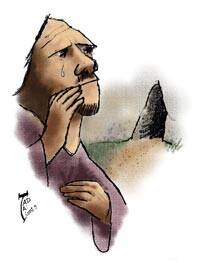The Greatest Sign
“I am the resurrection and the life” (Jn 11:25)
• How does resurrection differ from resuscitation?
• In what ways is the revival of Lazarus the greatest sign performed by Jesus, according to John?
• Where does Jesus’ resurrection fit in your spirituality?
The reading from Ezekiel 37 is part of the famous vision of the valley of the dry bones. The prophet sees a vision of his people rising from death to life; he sees their dry bones coming to life again with flesh restored upon them. The vision is a grand metaphor of hope for Israel in exile in Babylon in the 6th century B.C.: the people that seemed to be dead will come to life again. That was Ezekiel's great hope.
The reading from John 11 tells how Jesus restored his friend Lazarus to life. It is the last and greatest of the seven signs or miracles that the Johannine Jesus performs during his public ministry. It is more than a resuscitation (since Lazarus has been dead for three days) and less than a resurrection (since we assume that Lazarus will die again). It is a sign pointing to the resurrection of Jesus. What Jesus does for Lazarus, his heavenly Father will do for Jesus and more. Jesus will not die again. Indeed, in his resurrection Jesus will conquer death. Thus Jesus restoration of Lazarus to life is a preview of Jesus own resurrection from the dead.
The raising of Lazarus is first and foremost a sign about Jesus. The narrative emphasizes Jesus' personal affection for Lazarus and his sisters. He loves these people and shows compassion toward them. It also emphasizes Jesus' great power in his ability to restore Lazarus to life again. And it helps to explain what led to Jesus' arrest and execution, since this last public action by Jesus in John's Gospel arouses the jealousy and fears of his opponents and sets in motion the plot against him that leads to his execution.
The last great sign points us toward the Johannine passion narrative. It signifies that the death Jesus undergoes on Good Friday is not ultimately a defeat, since Jesus has power over death. The purpose of the raising of Lazarus was that Gods glory might be made manifest in this event. It is a sign that Jesus passion, death, resurrection and exaltation constitute one glorious event in the history of our salvation. Jesus being lifted up on the cross is part of his being lifted up to eternal glory with his heavenly Father.
The Lazarus story has import for us. In the middle of the account, Jesus declares, I am the resurrection and the life. He goes on to affirm that whoever believes in me, even if he dies, will live, and everyone who lives and believes in me will never die. Most of us are accustomed to regard eternal life as something that begins only when we die. But Jesus asserts that for those who believe in him, eternal life has already begun. Who we are now is what we shall be forever. For us, as for Jesus, physical death is not a defeat. Rather, it is another step on the way to fullness of life with God. For us eternal life has already begun, and the best is yet to come.
The reading from Romans 8 concerns the link between the resurrection of Jesus and our resurrection. Paul and other early Christians were convinced that Jesus had been raised from the dead. In fact, Paul identifies God as the one who raised Christ from the dead.The great corollary of belief in Jesus resurrection is the possibility of our resurrection. Because Jesus has been raised from the dead, we too can hope to share in his resurrection. If the Holy Spirit dwells in us (as the beginning of our eternal life), that same Spirit can give us a full share in the resurrected life of Jesus. Thus Paul reminds us that Christian spirituality is based on Jesus' death and resurrection, that it is guided by the Holy Spirit dwelling within us and that we must respond to the promptings of the Holy Spirit. We can do so by prayer, the sacraments, good deeds, compassion for those in need, meeting the challenges of everyday life and cultivating the great Christian virtues of faith, hope and love.
This article also appeared in print, under the headline “The Greatest Sign,” in the March 3, 2008, issue.










